Ysterhout Dot Net
I recently came across a fellow reloader selling some equipment specifically for rifle reloading, co-incidentally exactly what I was looking for, and was happy to purchase. The equipment was, by first inspection, virtually unused.
This was that reloader's first reloading press, and no expense was initially spared, a best quality unit having been bought with all the upgrades available at the time.
Top quality brand - RCBS, top quality press - Pro 2000, yet the reloader was unhappy enough to want to sell it, having replaced it with a Forster Co-Ax.
That reloader went shopping for a rifle reloading press, and came home with a progressive press able to reload rifle cartridges. The press was used to reload a few rounds of 375H&H, with better success loading .308, maybe a couple hundred rounds, then it was put away and never used again.
One of the memorable issues faced by the reloader was the induced flex in the bench from the force applied to the press handle.
I'm going to use this scenario as an example for you to guide your decision on going progressive for rifle. This will explain why the progressive setup didn't work out as expected as a first and only press, and how you can avoid these issues, and reasonably employ your progressive press for bottleneck rifle case reloading.
... or why do people reload for rifle on a progressive.
The reason is to save time. It's the same reason why people reload for handgun on a progressive.
Competitive rifle shooters are the pioneers of progressive reloading for rifle cartridges. Competitive rifle shooters have day jobs. Everything related to the sport can be sponsored for them. However, very few professional rifle shooters shoot factory ammo. The vast majority reload. They may get their reloading equipment sponsored, but not the ammo. The best shooters all reload. When you shoot rifle competitively, you need a couple thousand rounds for the sport season. Plus you have a day job. Plus a family, etc., so time is a premium, and a progressive reloading press can save time.
A progressive rifle reloader can be used by anyone, for any purpose, but it's competitive sport shooters that got that ball rolling.
.. or why a progressive press is not the best choice for rifle reloading.
All progressive presses have a shellplate. The shellplate is bolted to the ram, and rotates in fixed increments with every cycle of the handle. The shellplate can handle a degree of tensile stress. Depending on how the progressive press is designed, either
- the base of the case slides on the carrier plate, such as with the Hornady LnL
- the base of the case rests on the shellplate, such as the RCBS Pro 2000
For the LnL style mechanism, when a case enters the sizing die, the force bears down on the carrier plate in compression, and there is no tensile stress on the shellplate retaining bolt. When the case exits the sizing die, there is resistance between the brass case and the die, requiring an opposite force to extract it. This opposite force applies a tensile stress to the shellplate which in turn applies a large axial tensile stress to the shellplate retaining bolt.
For the Pro 2000 style mechanism, when a case enters the sizing die, the force bears down on the carrier plate in compression, and there is a small tensile stress on the shellplate retaining bolt. When the case exits the sizing die, there is resistance between the brass case and the die, requiring an opposite force to extract it. This opposite force applies a tensile stress to the shellplate which in turn applies a large axial tensile stress to the shellplate retaining bolt.
The shellplate has to pull the case out of the die. The force needed to extract the case from the die will vary, larger cases need more force.
This absorption of energy causing flexing parts means more force needs to be applied to a progressive press for case sizing, than on a single stage.
All the force needed to extract the case from the sizing die applies a tensile stress to the shellplate, and a tensile shear stress to the retaining bolt. This is more significant the bigger the case is.
When we talk about pistol reloading, the case is relatively small, so the force needed to extract the case from the sizing die is far below tensile stress capability of the shellplate retaining bolt, and the shellplate itself. The practical result of this is that a progressive press can reload many thousands of pistol caliber reloads, without undue wear on the shellplate retaining bolt.
With rifle reloading, the stress on the shellplate retaining bolt is much higher. The working life of the parts is less, and progressive presses that reload rifle ammo experience much higher rates of part failure due to wear and tear centered around the shellplate retaining bolt.
... or why charging bottleneck rifle cases with extruded powder from a case-activated powder measure is not reliable.
All progressive presses have a case-activated powder measure.
For rifle reloading, there are only two types of powder - ball powder or extruded powder. Extruded powder is available in short cut form, where the grains are not as long as regular extruded. Hodgdon H4831SC, for example.
These powders behave very differently when poured into a narrow opening, such as a powder drop tube in a case-activated powder measure.
When a measured quantity of ball powder is poured into a narrow funnel, for example, gravity is sufficient for the powder to flow through. For the same quantity of extruded powder, the powder may flow through completely, or it may partially flow through and the remainder jam up in the opening.
Exactly the same thing happens inside a case activated powder measure.
A case-activated powder measure on a progressive press works best with ball powders.
Referring back to the background case, the reloader was intent of reloading .375 H&H, so most likely was using an extruded powder. The H&H case needs a large amount of powder, so the combination of a large quantity of extruded powder dropping all at once into the drop tube bushing probably caused unreliable powder dispensing, which made the reloader give up on trying to reload .375 H&H after just a few rounds.
You can certainly use a case-activated powder measure with extruded powder, just keep in mind that the narrower the opening that the powder has to flow through, the more likely the powder is going to jam up before it gets into the the case. Most problems will be encountered with long grains of extruded powder and bottle-neck rifle cases, and will be magnified if you use a smaller bushing in the drop tube.
... or things you can't do easily or cheaply on a progressive press.
So your combination of powder type and charge weight meters well. You're not in the clear yet.
A vital part of rifle reloading is case preparation. At a minimum, cases must be trimmed to max allowable trim length, and correctly sized.
Those are two operations that can be done reliably on a progressive press, with the right additional equipment :
- rifle brass can be trimmed on the press using an electric case trimmer attatchment
- and sized using carbide dies, such as made by Dillon.
Using carbide dies, the case lubing of the rifle brass is not critical, carbide dies can resize rifle brass that are un-lubed.
Most of us have neither of those, but we do have a progressive press, and we can use regular rifle dies to resize on a progressive press. For which, each case must be properly lubed, and here lies the problem : just because you lubed a rifle case, does not mean it will smoothly cycle through your progressive reloader.
Again, a progressive press is definitely capable of resizing rifle brass. But unless you are using carbide dies, it is not totally reliable, in that you are not assured of a proper case sizing on every pull of the handle. Loading 10, 20 or 50 rounds before you get a jam does not count as reliable, reliable means every stroke sizes the case, every time.
Fully progressive reloading for bottleneck rifle cases can be done by the same method as applied to pistol or revolver cases - ie : all operations on the press, one operation per stroke, one loaded round per pull of the handle, all operations completed in one press cycle - provided the case prep is done on the press, the sizing die is carbide, and the powder is either ball, or a small quantity of short cut extruded. As far as I know, only Dillon makes a .223 Remington and .308 Winchester siing die that is made from carbide. Other calibers and other manufacturers may exist as well, but the cost of that one die is as much as many entire reloading presses cost.
What about the rest of us that don't have a carbide full length sizing die and a press mounted case trimmer ?
For us, successful progressive reloading for bottleneck rifle cases is possible - pretty much anything in any caliber, provided you use a ball powder or short cut extruded, and provided that every operation on the press is trouble free. This means, if you size on the press, that every time you pull the handle you successfully size a case, and every powder drop is complete - no powder gets left behind in the drop tube.
For best efficiency, not all the operations are performed in one cycle. It may seem counter-intuitive to equate efficiency with multiple press cycles, but the time you're going to waste clearing jams is more than made up for when you split the reloading process into multiple cycles.
Full length sizing of bottleneck rifle brass does not always happen with one stroke, you may need to retract the case and depress the handle a second or third time, before the sizing is complete. For example, .223 Remington brass is notoriously difficult to resize, probably the reason why Dillon made the .223 carbide sizing die. Multiple strokes to resize one case does not work on a fully progressive press, because you hang up all the dependent operations, and it cannot operate in reverse.
Going back to the opening scenario, the reloader only bought the progressive press, no single stage. Which is a vital component for rifle reloading. It is absolutely necessary to have a single stage press as well.
The main reason you need a single stage press for rifle reloading is for load development. Load development is best done on a single stage. You can certainly do load development on a progressive, but you will age decades in just a few hours. It is not advisable.
I would strongly advise any reloader of rifle cartridges to get a single stage press first, before attempting to reload for bottleneck rifle on a progressive. As a beginner, you don't need a single stage press when you reload pistol calibers, you can buy the progressive, learn on it, and you're done. Rifle reloading is a little different - more steps involved - and different steps altogether. I can't recommend your first rifle reloading press to be a progressive only. If you must have the progressive, buy a single stage press to go with it, you need it for load development, and you will definitely need it if any step in the progressive cycle won't go smoothly.
Without the carbide sizing die, trouble free press operation is achievable if you brass prep beforehand. This means you size and trim the brass before using the progressive press. In the opening scenario, the reloader experienced excessive flex in the loading bench that the press was bolted to - it was a tough job to size the brass. This means that the press handle needed great force applied to size the brass, and an equally great force to extract the sized case from the sizing die. This issue can be addressed simply by using a good quality case lube that is lanolin based. If you still experience any diffculty sizing rifle brass on a progressive, don't try squeezing blood from a stone - the sizing operation can be more efficiently performed on a single stage press, when every case is properly lubed beforehand. There is much less wear and tear involved on a single stage, and you can repeat the sizing operation without messing with the entire reloading cycle. A known issue with the RCBS Pro 2000 is the shellplate retaining bolt breaking where it contacts the shellplate. Accelerated tensile failure from rifle reloading that would not occur even over a long period of time reloading handgun ammo.
To use your progressive press for rifle reloading will save you some time, even if you can only do one operation on the press per cycle, such as priming and or powder drop and or bullet seating. You don't need to do all the operations in one cycle. This means you can run the press with just one case on the shellplate at a time, and still save time over using a single stage press.
... or how to get it working either way.
There are two things to check before you begin, which will determine how many steps per cycle are possible with your equipment.
This does not apply to any Lee progressive press owner, as Lee has yet to make a reliable priming system. Any product that you need to modify after purchase to make work, is by default defective, as all Lee progressive press owners have found with their priming systems. By default, therefore, you cannot reliably prime rifle brass on your Lee progressive, so you have to prime it off press. There are people who claim their Lee progressive has a working priming system. What they consider working, and what I describe as working, differ. I consider something to be working when it works all the time, not just a few press strokes between endless fiddling and tweaking. The Lee progressive owner who has unboxed their Lee progressive, and loaded just 200 rounds without a priming malfunction, is someone the world has been waiting for since 1984 when Lee first created their automatic priming system in the Pro 1000.
If anyone knows Mr Lee Junior, please pass this on :
Mr. Lee, it's long past the time to retire your priming systems design team, and hire new talent. After 37 years of making automatic priming systems that don't work, wipe the slate clean. You make brilliant products, but your automated priming is a festering boil. The answer to the priming problems is not the Automatic Case Primer. You already had the finest reloading press in the Lee Loadmaster. All you had to do was give it a reliable automatic priming system, and you would have owned the reloading world.
The first thing is determine how reliable the case sizing operation is, on your press, using your fired brass in your sizing die, with your case lube. The sales guy said the press can reload anything. So test it. If you can size 100 pieces of bottleneck rifle brass with 100 pulls of the handle, using properly lubed cases and no excessive force, then your press is good for sizing. If not, you will save a lot of time sizing your brass on a single stage press first.
You should never have to apply excessive force either, remember, the more force you apply, the faster parts are going to break.
The second thing is to determine that your powder drop is reliable. Line up at least 30 pieces of fired brass, and run them through the progressive press with only the case activated powder measure, using your chosen charge weight and powder type. Weigh the contents of each of the 30 cases. If you are satisfied that the powder drop is repeatable, then your progressive press is good for the powder drop. If not, it means that you are getting a partial drop sometimes, and so you should drop powder manually, off the press.
At this point, you need to be aware that no case activated powder measure is ever able to drop the exact charge weight every time, no matter how expensive it is. This means you can't reasonably expect a great degree of precision from progressive reloads, although you can certainly achieve very good consistency.
Even if both of the above steps are not reliable on your press, with your combination of components, you can still use your progressive press to reload the rifle ammo.
Once the brass is sized and trimmed off-press, you can prime the brass on the progressive much faster than with any hand priming tool. Except if it's a Lee. Any hand prime works faster than progressive priming on a Lee.
Once your primed brass has the correct powder fill, you can cycle it through the progressive press for bullet seating. Bullet seating goes much faster on a progressive than on single stage.
Every progressive press is certainly capable of reloading rifle ammo, but not every combination of equipment is suitable to do so reliably and consistently for your use case. Progressive reloading of rifle ammo is not as easy as progressive reloading for handgun ammo, so don't be disappointed when you can't produce one rifle round with every pull of the handle from a single press cycle.
Identify which steps in the process your press can easily handle, and do the steps it can't manage off press. You will still save time compared to reloading everything single stage.
... or how it works in real life.
Each manufacturer has their own marketing script, and basically everybody says their product can do everything. Not untrue, the devil just lurks in the details. No manufacturer advertises their hobby presses as fully automatic, just as progressive. There is a big difference. The average person assumes they mean automatic when they say progressive. A progressive press can be fully automatic, you just have to throw enough money at it.
To illustrate the point, this is a commercial rifle ammunition machine, which is fully automatic. A reloading press is a kid's toy compared to that.
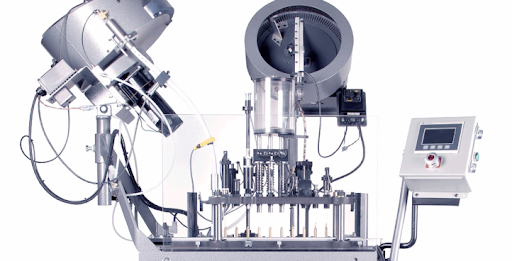
Compare to that, in order, a fully automatic hobby press, an automated progressive hobby press, and a progressive hobby press, and this last type is most commonly used to reload progressive rifle.
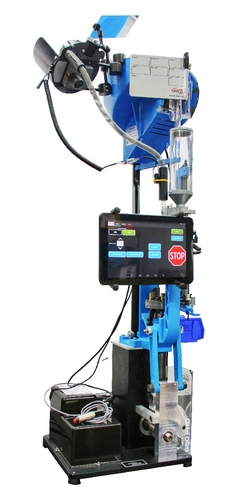 | 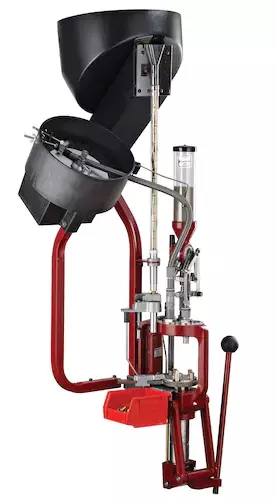 | 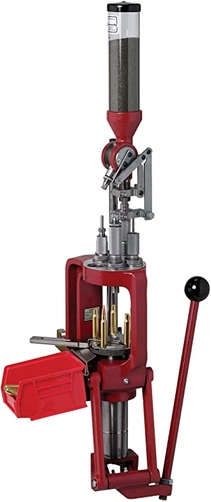 |
When a progressive press manufacturer tells you their press can reload any rifle ammo, you immediately have a beautific vision of your rifle dies and automatic powder dispenser set up on a press, with a full shellplate of rifle brass, clicking softly under the soft glow of golden light, dropping one perfectly loaded rifle round with every cycle of the handle.
That's not what happens in the real world.
This progressive press is a RCBS Pro 2000. RCBS says, in their product info, the press can reload up to 460 Weatherby. The press certainly can. What they don't tell you is exactly how you should go about it.
Incidentally, you can load .460 Weatherby on any progressive press, only the degree of difficulty will vary.
Rotating one case on the shellplate as you cycle through all the stations is still defined as progressive reloading. And progressive reloading doesn't mean all the case operations have to be on the same press.
I don't have a .460 Weatherby to reload for, but I do have a .375 H&H, and I'll describe the least stressful method of using this press to reload .375 H&H ammo. This method applies to you and your rifle reloading on your progressive press, no matter what press you have. Even a Lee.
I've tested the powder drop with the RCBS case-activated powder measure that comes with this press. Using the largest bushing that it comes with, I can't get reliable powder drop. This is not a RCSB problem. I know this because I have other case-activated powder measures from other manufacturers, and they all behave the same. I'm sure the powder drop is erratic because I'm dispensing 64 grains of extruded powder. When the powder drops, it cannot flow smoothly. Some gets jammed in the drop tube. Like a log-jam in a narrow stream. This results in the odd case coming out undercharged, and the next one overcharged. Testing this with a powder indicator die, the powder level varied by one full centimeter across five cases with my equipment. At this point, I could waste further days and weeks trying to get reliable powder throw, but I already know it's not possible. Reliable case-activated powder drop is not possible with my equipment / powder combination. It does not mean this equipment can't do progressive rifle. It certainly can, just not with my combination of components.
If I was reloading something small, like a Creedmoor, and using a ball powder, it would be very reliable. Even up to 30-06 with ball powder is no problem. I do expect if I used a suitable ball powder for .375 H&H, it would also work. But I only use extruded for big bores, and I'm not prepared to go through the trouble of a powder change just to save a couple of minutes reloading.
I have not tried sizing the brass on this press, because I know from experience that unless the sizing die is carbide, the sizing is not reliable.
Your experience may differ. You may have experienced no glitches whatsoever sizing your 6mm BR, Creedmoor or other small capacity rifle brass in your progressive press, in which case you have no reason not to use it for the sizing.
My rifle sizing is best done on a single stage, because I never know if one stroke is enough to properly size. You will easily be able to neck-size only on the progressive, but that just causes bigger problems with the ammo, and is not recommended. Full length size only, allways.
This press can prime. It has the primer tube upgrade, and cycles like a clock. Your press may not be reliable on the prime - no big deal, easy workaround, lot's of bench mounted and hand priming tools available.
So I have prime and bullet seat, no sizing, no case-activated measure. Not having a case-activated measure still means I can add powder on the press. There is a way to do it easily, with great precision, it just takes a bit longer.
The way this press will work for me, is prime - powder - bullet seat, all in the same cycle, with a full shellplate. Sizing will be done before-hand on a single stage, and all brass checked for trim length. I have a CH4D who's job it is to size brass. You can use any single stage press. You just cannot use any case lube. Use the best quality case lube you can find [ avoid any spray type on rifle brass ] , it'll most likely be lanolin-based.
The sized brass goes on the shellplate, then is primed. Next station is the powder drop. I place a funnel neck-down where the powder measure should be. On the upstroke, the case mouth rises into the funnel, which ends up seated on the case mouth. This is reliable, the outcome is exactly the same every time action is performed.
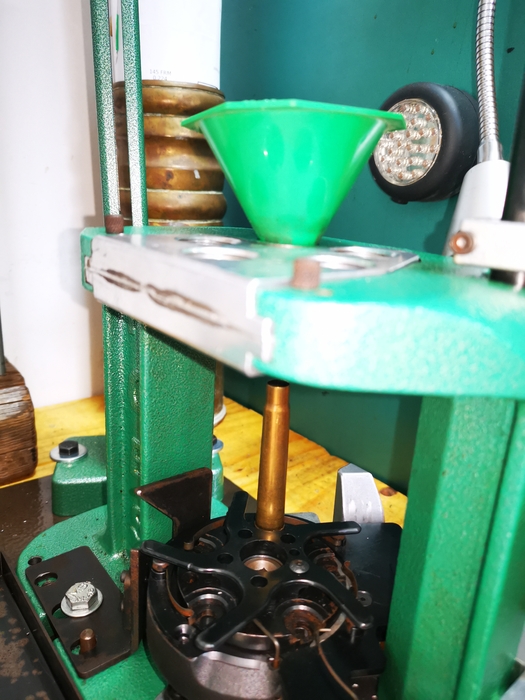 | 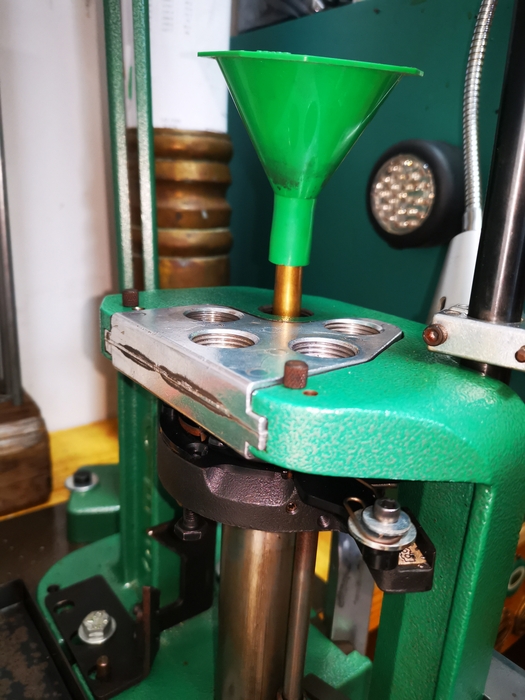 |
I then pour the powder charge that I've dropped from my manual powder measure, and trickled to the correct weight on my electronic scale, into the funnel, charging the case. I use the exact powder charge each time, which means precision. That's the slow part. It takes me around 15 seconds to charge the case. During that time, the ram is at the top of the stroke, waiting patiently. Once that is done, next stage is bullet seating.
That gives me 3 operations within the same cycle on a full shellplate of brass. Which by definition is progressive reloading. And time is saved compared to doing every operation on a single stage press only.
 Rifle Progressive, or Not
Rifle Progressive, or Not


